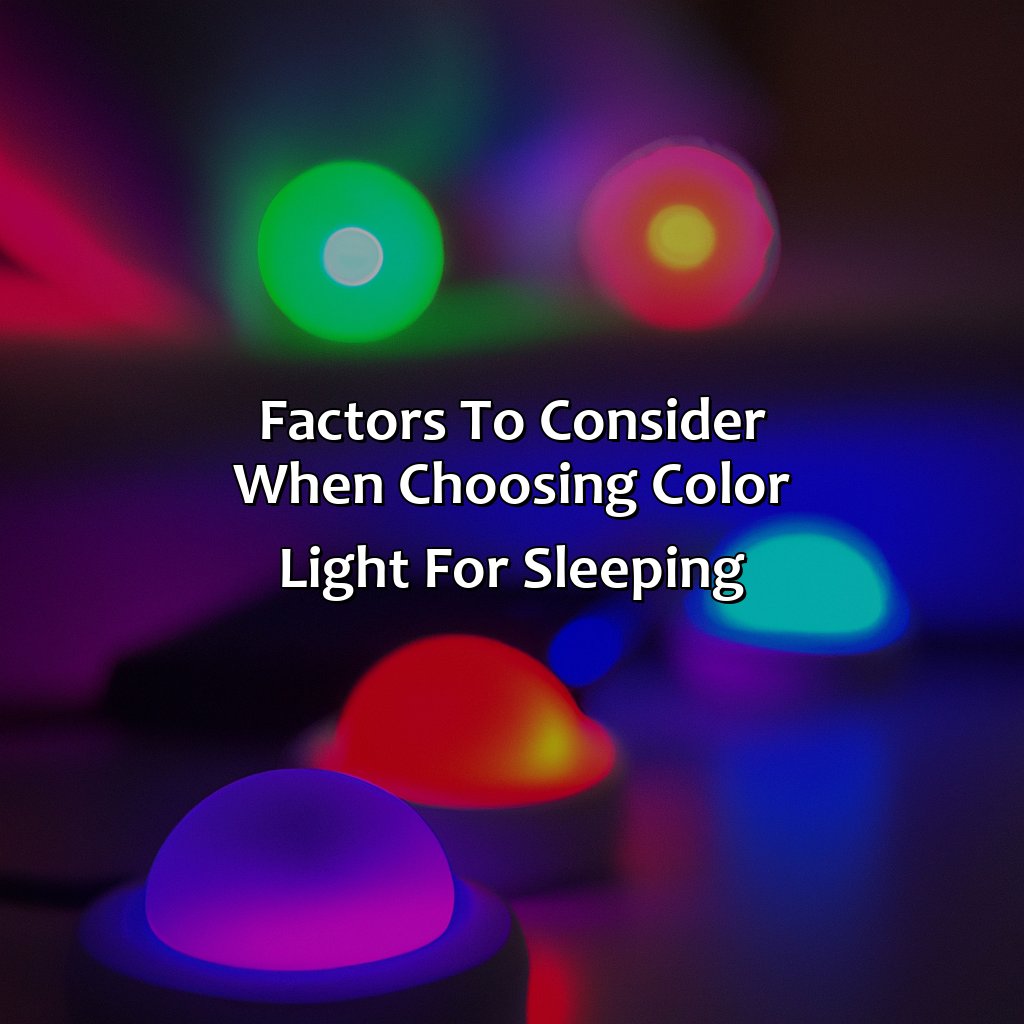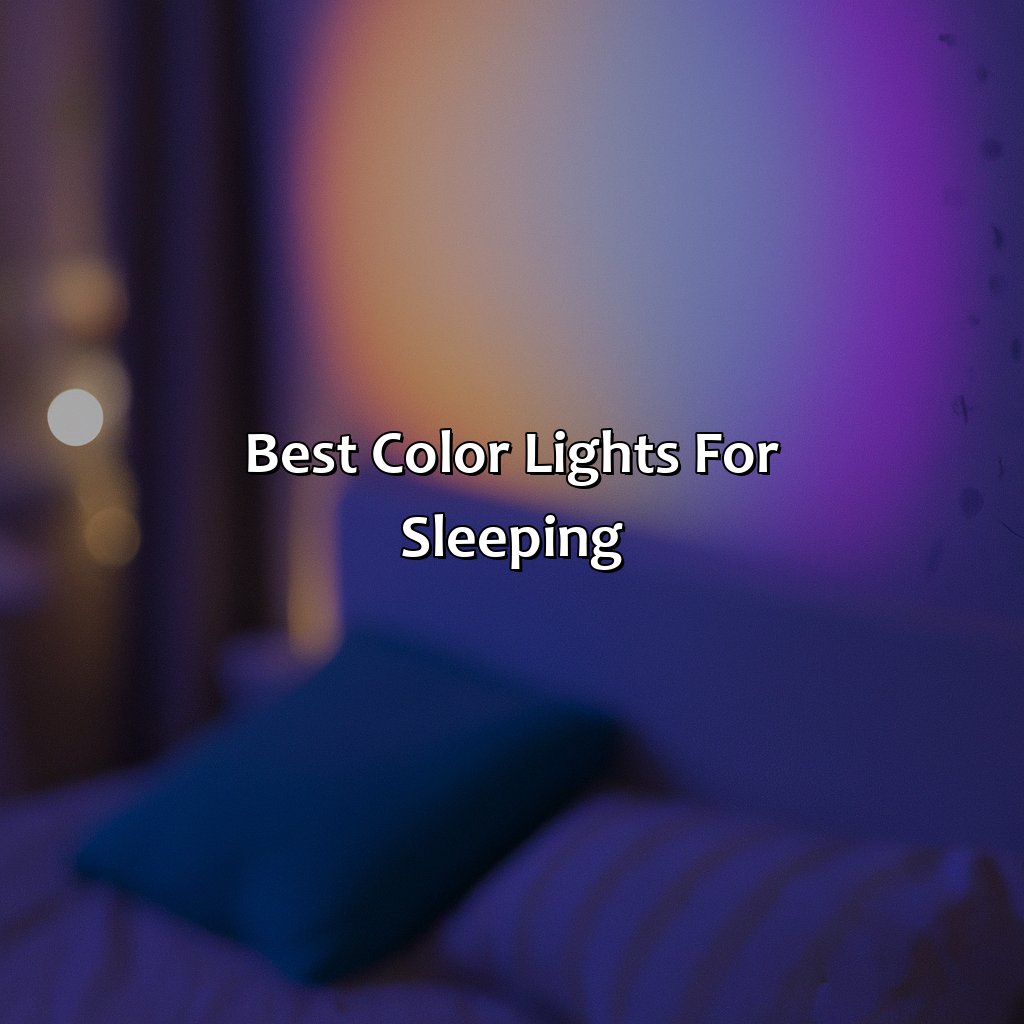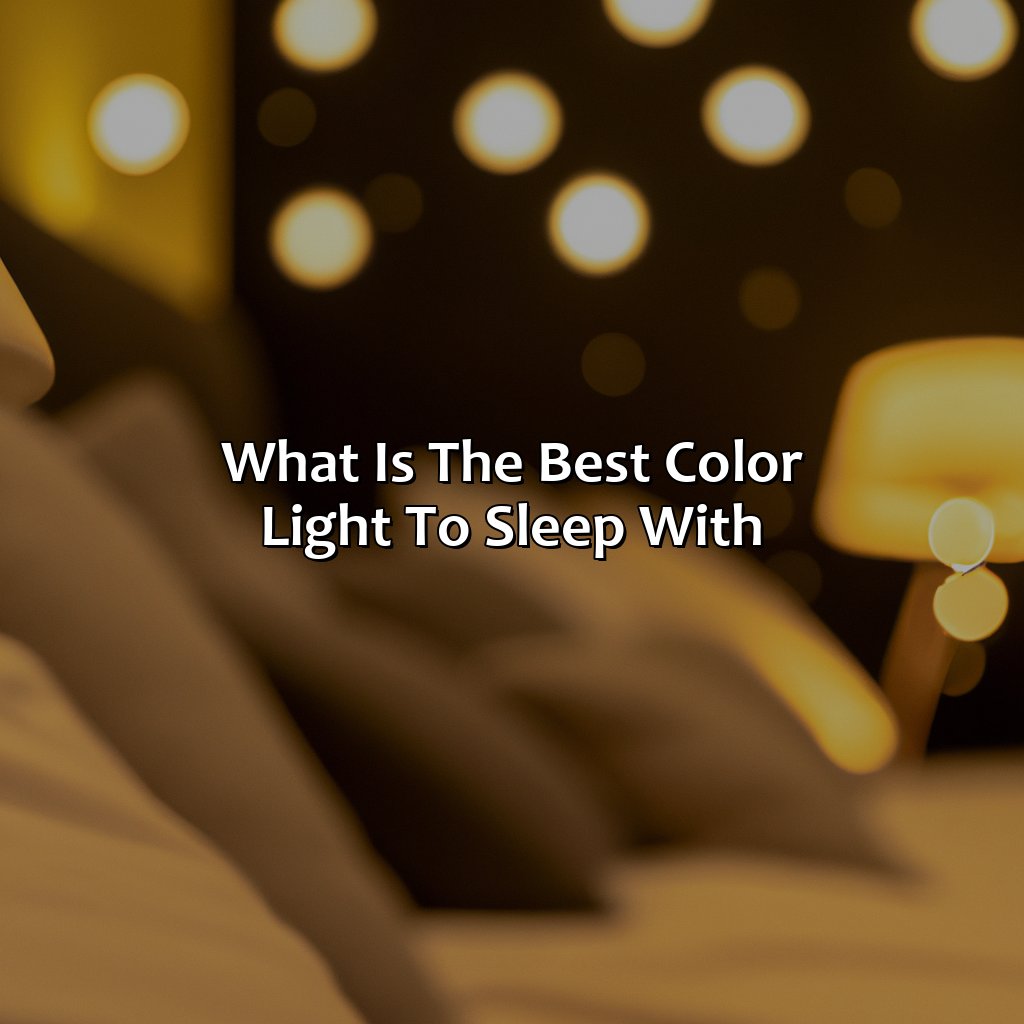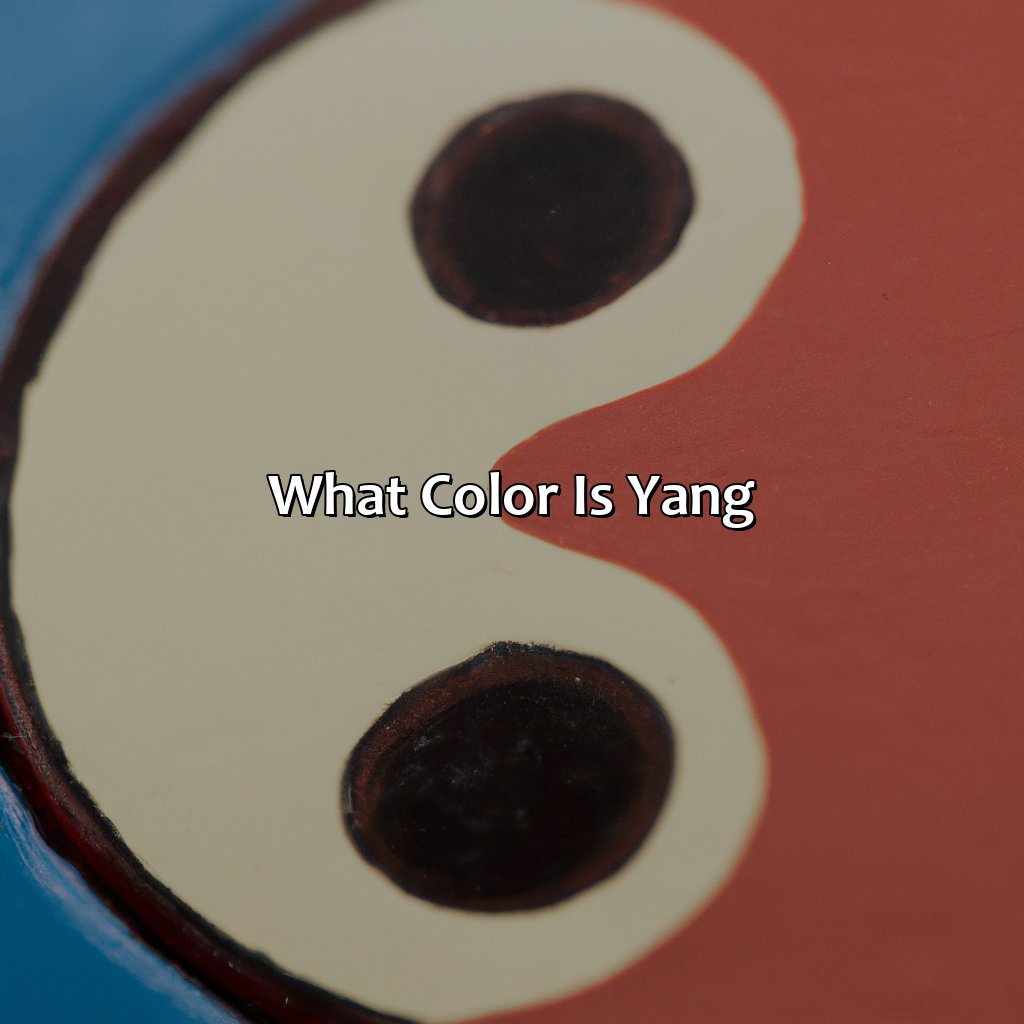Key Takeaway:
- Choosing the right color light for sleeping is crucial in maintaining good sleep hygiene. It can help regulate the body’s circadian rhythm and promote the production of melatonin, a hormone essential in inducing sleep and maintaining sleep quality.
- Factors to consider when choosing color light for sleeping include personal preference, mood, glare, eye strain, light sensitivity, relaxation, bedtime habits, evening light therapy, natural light, and the type of light source. Red, amber, orange, yellow, and green light are commonly used to promote relaxation and induce sleep.
- It is important to note that the effects of light on sleep vary depending on individual factors, such as sleep disorders, insomnia, jet lag, and shift work. Consulting a sleep specialist or using therapeutic light boxes, sleep gadgets, and apps can help in addressing sleep-related issues.
Importance of choosing the right color light for sleeping

Photo Credits: colorscombo.com by Kenneth Wilson
Choosing the appropriate color light to sleep with is vital for maintaining a healthy circadian rhythm. The color of light significantly influences the release of melatonin, which regulates the sleep-wake cycle. To promote a good night’s sleep, it is crucial to avoid blue light as it inhibits melatonin production and shifts the body clock to be later. Instead, choose warm-colored light like orange or red, as they have a lesser impact on melatonin and can enhance sleep quality. By understanding the impact of color light on our sleep cycle, individuals can take better control of their sleep health.
Furthermore, studies have shown that the intensity of light is equally crucial to consider. Higher intensity light suppresses melatonin more than a dimmer light. Dimming the lights in the evening and switching to warmer colors prepares the body for sleep. Additionally, creating a relaxing environment by eliminating all electronic devices and using blackout curtains can also improve sleep quality. Optimizing the right color light, darkness, and relaxation can help individuals experience better sleep.
Additionally, establishing a consistent sleep schedule is essential. Set a regular bedtime and wake-up time, avoid caffeine and technological devices in the evening, and get sufficient exposure to natural daylight during the day. These habits work together with selecting the appropriate color light to enhance the overall quality of sleep. Incorporating these small changes into our routine can positively impact our health and overall well-being.
Factors to consider when choosing color light for sleeping

Photo Credits: colorscombo.com by Raymond Hernandez
Choosing the best color light for sleeping is important. To help, we have “Factors to consider when choosing color light for sleeping.” Learn about personal preference, glare, eye strain, and light sensitivity. Explore bedtime habits, evening light therapy, natural and dim light, LED lights, red, green, yellow, violet, and orange light. Also, look at color temperature, UV light, fluorescent light, incandescent light, luminance, lux level, visual comfort, and light pollution.
The section has two sub-sections: “Circadian rhythm” and “Melatonin production.” In the first, learn about sleep disorders, insomnia, jet lag, shift work, sleeping patterns, sleep duration, and deprivation. In the second, study therapeutic light, calming sleep, light boxes, sleep accessories and gadgets, apps, tracking, wake-up light, sleep training, coaching, counseling, education, and awareness.
The section finishes with a “Personal preference and mood” sub-section. Learn about color psychology, color theory, light psychology, relaxation techniques, sleep inducing colors, visual stimuli, and chromotherapy to understand the connection between preferences and mood to sleep.
Circadian rhythm
The body’s internal clock, or the natural sleep-wake cycle, is referred to as the “daily rhythm.” It determines when you feel alert and when you feel tired, and it is regulated by light exposure. The circadian rhythm plays an essential role in sleep disorders like insomnia, jet lag, shift work sleep disorder and other sleeping patterns.
Bright light in the morning helps turn off melatonin production (the hormone that makes you sleepy), while dim light in the evening promotes its release. Choosing a color of light to attain optimal sleep duration may help balance out your natural circadian rhythms and avoid sleep deprivation.
Get your melatonin naturally with the right light, not from light boxes, sleep masks, and gadgets that make you resemble a sci-fi character.
Melatonin production
The production of melatonin, a hormone controlling the circadian rhythm and sleep cycle, is deeply influenced by light exposure. Exposure to bright lights such as blue and white interferes with the body’s natural melatonin production, which makes it harder for individuals to fall asleep at night. Therefore, it is crucial to expose ourselves to red, amber, or green light that support calmness and enhance relaxation. In essence, choosing the right color light for sleeping promotes therapeutic light for calming sleep while reducing the impact of light boxes or electronic devices.
In addition to supporting melatonin productions through correct colored lights like green or yellow lights when selecting light gadgets or apps is needed for achieving optimal sleep hygiene. Sleep masks can also assist in blocking out all excess glare. Wake-up lights are another popular gadget that helps imitate sunlight for a natural awakening process.
It’s critical to consider several therapeutic aspects when choosing colors’ lighting in soothing ways. Personal preferences and mood should suit an individual’s style best for effective and sustained use of counseling sessions on its importance. Lastly, one must seek professional training on how to incorporate sleep coaching practices into daily routines.
Research has shown that people need about seven hours of high-quality sleep at night to maintain their well-being also the amount of blue light emitted from TVs, computers, and phone screens suppresses melatonin levels.
Who needs a therapist when you can just choose the right color light to match your mood and preferences for a good night’s sleep?
Personal preference and mood
Color preference and mood play a significant role in selecting the appropriate color light for sleeping. The psychology of colors, known as chromotherapy, explains how visual stimuli can have an impact on our emotional well-being. Different individuals might react differently to specific colors based on their personalities and disposition. Additionally, color theory suggests that darker shades tend to induce relaxation while brighter shades promote energy and alertness.
Furthermore, relaxation techniques are crucial when choosing the best color light for sleeping. For instance, amber or orange lights can enhance sleep quality by producing a warm and cozy feeling, thus reducing stress levels. Similarly, yellow lights provide soft illumination without disrupting melatonin production during bedtime.
In contrast, green light has a calming effect and is recommended for those who desire a tranquil environment with reduced anxiety levels while preparing to go to bed. However, blue light appears to negatively affect sleep by disrupting melatonin production.
Lastly, white light should be avoided before bedtime since it suppresses natural melatonin production and energizes the body instead of promoting relaxation. Therefore, it’s vital to consider personal preference and mood when choosing the best color light for sleeping.
A friend was struggling with falling asleep and mentioned her room’s bright white light was not helping her situation. I suggested she try softer hues like amber or orange as these warm colors were sleep-inducing according to research; She gave it a try and reported that after replacing her bright white bulbs with soft orange ones she could finally fall asleep quickly throughout the night consistently.
Sleep tight with the right hue: here are the colors you should choose:
Best color lights for sleeping

Photo Credits: colorscombo.com by Kenneth Adams
In this article, we explore the optimal color lights for sleep. The importance of sleep is paramount, and the color of light in a room can significantly affect the quality of sleep. Below, we break down the best color lights for sleeping into three points:
- Red light: The most effective light for sleep as it promotes the production of melatonin.
- Amber or orange light: This creates a warm and cozy atmosphere, highly conducive to sleep.
- Yellow light: Low-intensity yellow light has a soothing effect on the eyes and promotes relaxation.
It’s worth noting that green, blue, and white light are not as effective for sleep as they can suppress melatonin production.
When it comes to creating the ideal sleep environment, important details include choosing bulbs with lower wattage, using dimmer switches, and avoiding screens at least an hour before bedtime.
Pro Tip: Utilize “smart” lighting systems that allow you to customize and program the color and intensity of light in your bedroom. This way, you can create the perfect sleep environment and minimize disruptions to your sleep cycle.
Five Facts About the Best Color Light to Sleep With:
- ✅ The best color light to sleep with is a warm, reddish-orange hue. (Source: Sleep Foundation)
- ✅ Blue light disrupts the production of melatonin, a hormone that promotes sleep. (Source: Harvard Health Publishing)
- ✅ Yellow and green light also have less of an impact on melatonin production than blue light. (Source: Medical News Today)
- ✅ Bright and cool light, such as white fluorescent bulbs, can interfere with sleep and affect the body’s circadian rhythms. (Source: National Sleep Foundation)
- ✅ Himalayan salt lamps emit a warm, pinkish-orange light that may promote relaxation and sleep. (Source: Healthline)
FAQs about What Is The Best Color Light To Sleep With
1. What is the best color light to sleep with?
The best color light to sleep with is red. Red light has a longer wavelength and is less likely to disrupt your natural circadian rhythm, making it easier to fall asleep and stay asleep.
2. Can blue light affect my sleep?
Yes, blue light can affect your sleep. Blue light has a shorter wavelength and can suppress the production of melatonin, a hormone that regulates sleep. Therefore, it is not recommended to use blue light for sleeping.
3. Is it okay to sleep with white light?
It is not recommended to sleep with white light. White light has a high color temperature, which can make it difficult to fall asleep and stay asleep. However, if you must use white light, try using warm white light with a lower color temperature.
4. Does the brightness of my light affect my sleep?
Yes, the brightness of your light can affect your sleep. Bright light can suppress melatonin production and make it difficult to fall asleep. It is recommended to use dimmer light for sleeping.
5. Are there any other colors of light that are good for sleeping?
Yes, besides red light, orange light and yellow light can also be good for sleeping. These colors also have longer wavelengths and can also help regulate your circadian rhythm.
6. Should I use night lights for sleeping?
It is okay to use night lights for sleeping as long as the light is not too bright or too blue. Try using warmer, dimmer night lights to help you fall asleep easier and stay asleep longer.






